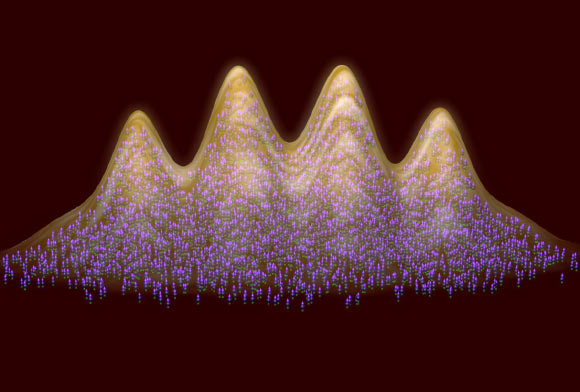Predicted five decades ago, supersolidity is an exotic phase of matter where superfluidity and crystalline order coexist. By combining theory and experiments, a team of physicists from Austria demonstrated that dipolar quantum gases of two lanthanide metals — erbium and dysprosium — support a state with supersolid properties.

Several tens of thousands of particles spontaneously organize in a self-determined crystalline structure while sharing the same macroscopic wavefunction — hallmarks of supersolidity. Image credit: University of Innsbruck.
In a supersolid, atoms are arranged in a crystalline pattern while at the same time behaving like a superfluid, in which particles move without friction.
“While most work has focused on achieving supersolidity in helium, researchers have recently turned to atomic gases, in particular, those with strong dipolar interactions,” said first author Dr. Lauriane Chomaz from the Institute for Experimental Physics at the University of Innsbruck and colleagues.
“Recent experiments have revealed that such gases exhibit fundamental similarities with superfluid helium. These features lay the groundwork for reaching a state with both spontaneous density modulation and global phase coherence, which are indicators of supersolidity.”
The two supersolids made by the team were created using erbium and dysprosium quantum gases.
“We experimentally created states showing these characteristics of supersolidity by tuning the interaction strength between the particles, in both erbium and dysprosium quantum gases,” the scientists said.
“While in erbium the supersolid behavior is only transient, our dysprosium realization shows an unprecedented stability,” said senior author Dr. Francesca Ferlaino, from the University of Innsbruck and the Institute for Quantum Optics and Quantum Information of the Austrian Academy of Sciences.
“Here, the supersolid behavior not only lives long but can also be directly achieved via evaporative cooling, starting from a thermal sample.”
“Like blowing over a cup of tea, the principle here is to remove the particles that carry the most of energies so that the gas becomes cooler and cooler and finally reaches a quantum-degenerate stationary state with supersolid properties at thermal equilibrium.”
“This offers exciting prospects for near-future experiments and theories, as the supersolid state in this setting is little affected by dissipative dynamics or excitations, thus paving the way for probing its excitation spectrum and its superfluid behavior.”
The results were published in the journal Physical Review X.
_____
L. Chomaz et al. 2019. Long-Lived and Transient Supersolid Behaviors in Dipolar Quantum Gases. Phys. Rev. X 9 (2): 021012; doi: 10.1103/PhysRevX.9.021012







